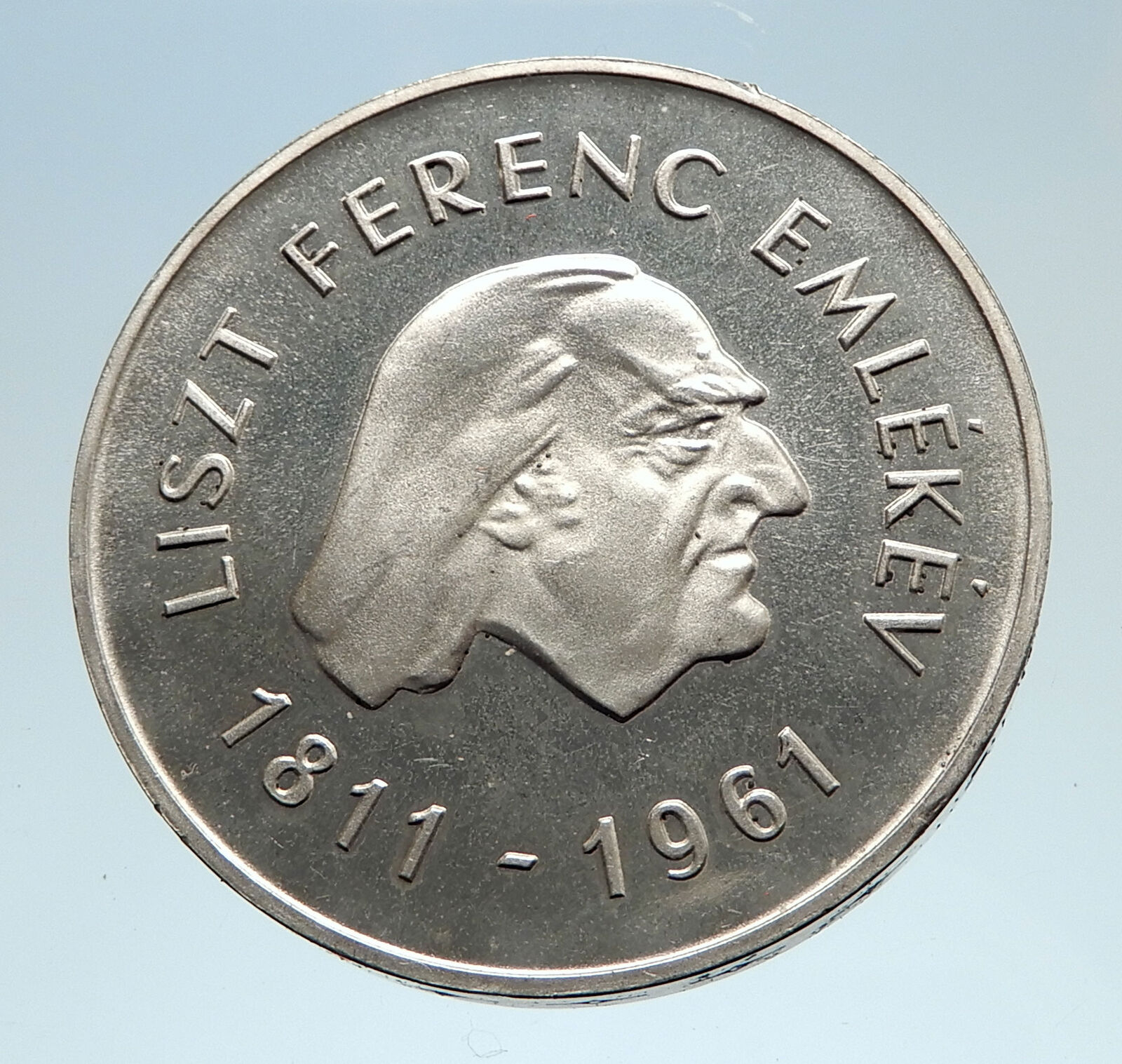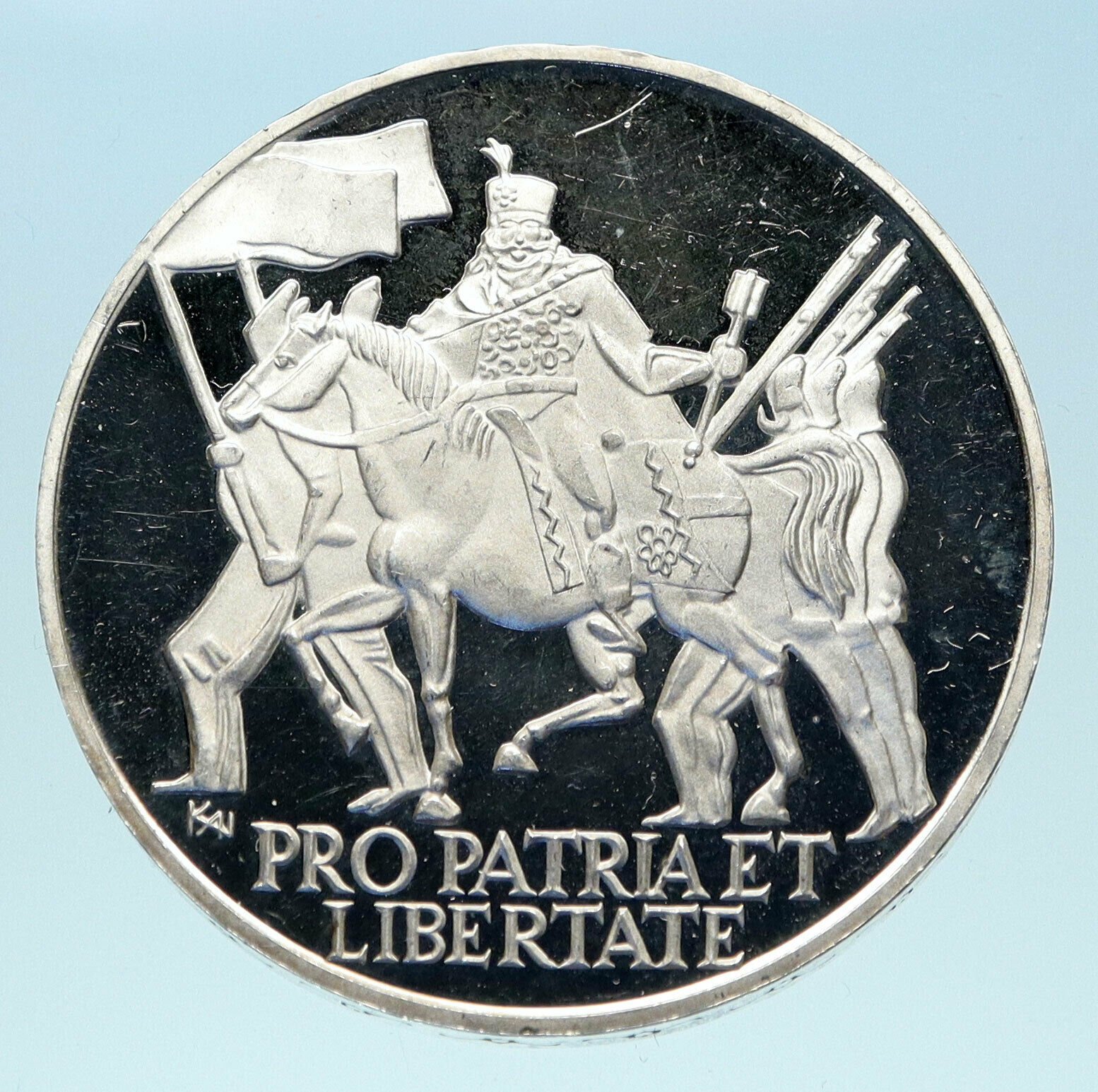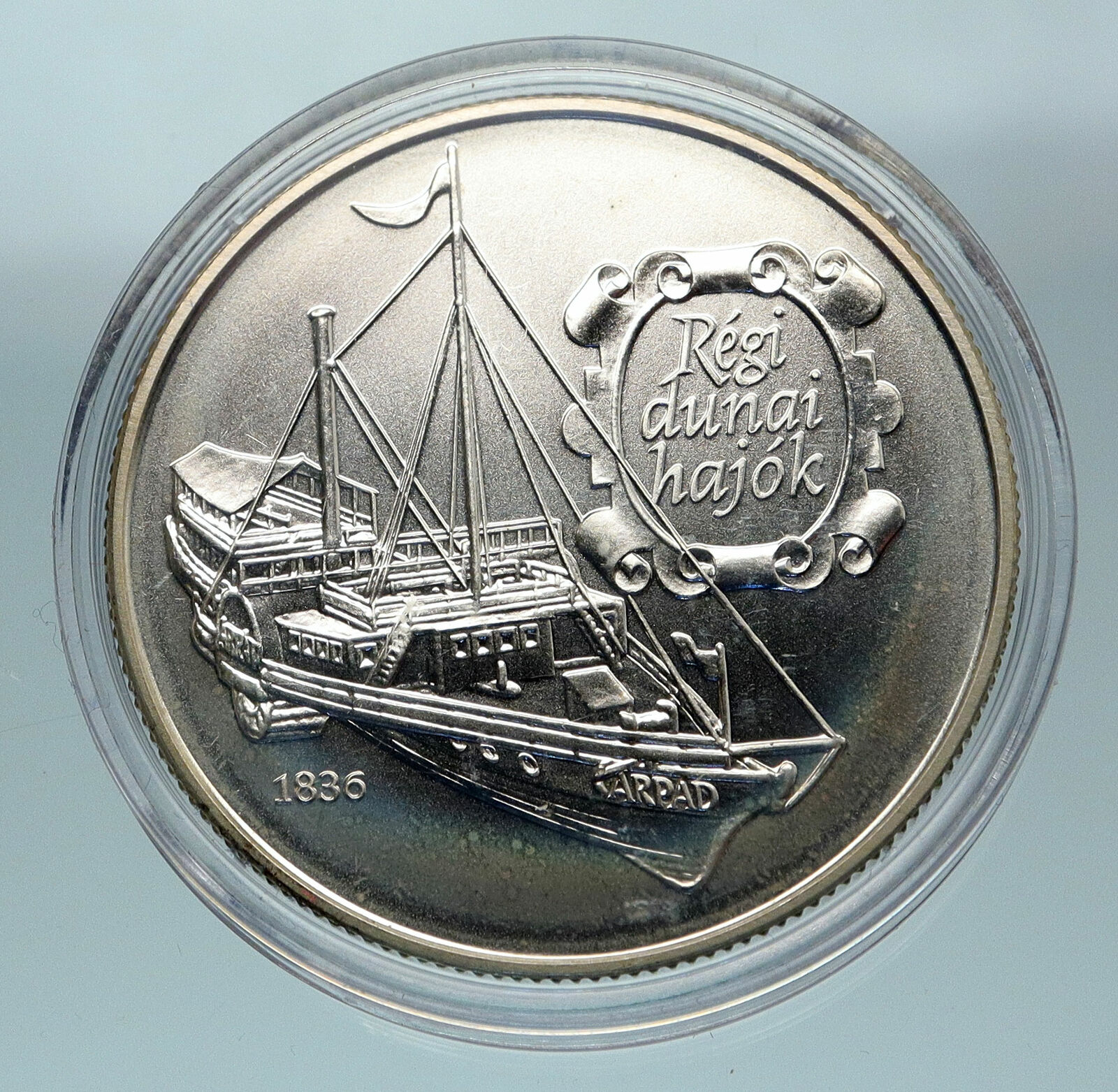|
Hungary – XIII Winter Olympics – Lake Placid
1980 Proof Silver 500 Forint 46mm (39.04 grams) 0.640 Silver (0.8025 oz. ASW)
Reference: KM# 619
MAGYAR NÉPKÖZTÁRSASÁG 500 FORINT BP. 1980 KZ., Ice-dancing pair.
XIII. TÉLI OLIMPIAI JÁTÉKOK 1980 LAKE PLACID N.Y. KZ., The emblem of the 13th Winter Olympic Games.
You are bidding on the exact item pictured, provided with a Certificate of Authenticity and Lifetime Guarantee of Authenticity.
The 1980 Winter Olympics, officially known as the XIII Olympic Winter Games, was a multi-sport event which was celebrated from February 13 to February 24, 1980, in Lake Placid, New York, United States. This was the second time the Upstate New York village hosted the Games, after 1932. The only other candidate city to bid for the Games was Vancouver-Garibaldi, British Columbia, Canada, which withdrew before the final vote (though Vancouver would eventually win the bid to host the 2010 Winter Olympics.)
The mascot of the Games was “Roni”, a raccoon. The mask-like rings on a raccoon’s face recall the goggles and hats worn by many athletes in winter sports. The sports were played at the Olympic Center, Whiteface Mountain, Mt. Van Hoevenberg Olympic Bobsled Run, the Olympic Ski Jumps, the Cascade Cross Country Ski Center, and the Lake Placid High School Speed Skating Oval.
Notable highlights included:
- The United States men’s ice hockey team, composed mostly of collegiate players and not predicted to advance beyond group play, won the gold medal. The United States team’s 4-3 win over the veteran and professional Soviet team, which came into the 1980 Games having won four consecutive Olympic gold medals, became known as the “Miracle on Ice” in US culture. The win captured the hearts of Americans, even though it was the win against Finland that secured the gold medal.
- Eric Heiden of the United States won gold in the 500m, 1000m, 1500m, 5000m, and 10,000m speed skating events, setting four Olympic records and one world record (10,000m) in the process and delivering 83% of the American gold medals (the only other gold, as noted above, was won by the hockey team). Heiden became the first person to win all five speed skating events, the first of only three to win five gold medals in individual events at a single Games (either Summer or Winter), and is still the only athlete to win five gold medals at one Winter Games.
- Sweden’s Ingemar Stenmark won both the giant slalom and the slalom.
- Hanni Wenzel won the women’s giant slalom and slalom, making Liechtenstein the smallest country to produce an Olympic champion.
- Ulrich Wehling of East Germany and Irina Rodnina of the USSR won their respective events for the third time, Wehling in Nordic combined and Rodnina in pairs figure skating.
- Aleksandr Tikhonov of the USSR earned his fourth straight gold medal as part of the 4 x 7.5 km biathlon relay team.
- Nikolay Zimyatov of the USSR earned three gold medals in cross-country skiing.
- Robin Cousins won gold for Great Britain in the men’s singles figure skating.
- East Germany won the most medals overall (23) but had fewer golds (9) than the USSR (10).
- In possibly the most dramatic duel of the games, Sweden’s Thomas Wassberg edged Finland’s Juha Mieto in the 15 km cross-country skiing by 0.01 seconds, the closest margin of victory ever in Olympic cross-country skiing.
- Although they did not get any medals, the People’s Republic of China entered the Olympic Games for the first time after the IOC agreed to designate the Republic of China “Chinese Taipei”.
- Lake Placid 1980 marked the first use of artificial snow in Olympic competition.
- Lake Placid 1980 was the last Olympics to be opened by the Vice President of the United States, as 1980 was a Presidential election year.

 Hungary is a sovereign state in Europe. It is situated in the Carpathian Basin and is bordered by Slovakia to the north, Romania to the east, Serbia to the south, Croatia to the southwest, Slovenia to the west, Austria to the northwest, and Ukraine to the northeast. The country’s capital and largest city is Budapest. Hungary is a member of the European Union, NATO, the OECD, the Visegrád Group, and the Schengen Area. The official language is Hungarian, which is the most widely spoken non-Indo-European language in Europe. Hungary is a sovereign state in Europe. It is situated in the Carpathian Basin and is bordered by Slovakia to the north, Romania to the east, Serbia to the south, Croatia to the southwest, Slovenia to the west, Austria to the northwest, and Ukraine to the northeast. The country’s capital and largest city is Budapest. Hungary is a member of the European Union, NATO, the OECD, the Visegrád Group, and the Schengen Area. The official language is Hungarian, which is the most widely spoken non-Indo-European language in Europe.
 Following centuries of successive habitation by Celts, Romans, Huns, Slavs, Gepids, and Avars, the foundation of Hungary was laid in the late 9th century by the Hungarian grand prince Árpád in the Honfoglalás (“homeland-conquest”). His great-grandson Stephen I ascended to the throne in 1000 CE, converting the country to a Christian kingdom. By the 12th century, Hungary became a middle power within the Western world, reaching a golden age by the 15th century. Following the Battle of Mohács in 1526 and about 150 years of partial Ottoman occupation (1541-1699), Hungary came under Habsburg rule, and later formed a significant part of the Austro-Hungarian Empire (1867-1918). Following centuries of successive habitation by Celts, Romans, Huns, Slavs, Gepids, and Avars, the foundation of Hungary was laid in the late 9th century by the Hungarian grand prince Árpád in the Honfoglalás (“homeland-conquest”). His great-grandson Stephen I ascended to the throne in 1000 CE, converting the country to a Christian kingdom. By the 12th century, Hungary became a middle power within the Western world, reaching a golden age by the 15th century. Following the Battle of Mohács in 1526 and about 150 years of partial Ottoman occupation (1541-1699), Hungary came under Habsburg rule, and later formed a significant part of the Austro-Hungarian Empire (1867-1918).
Hungary’s current borders were first established by the Treaty of Trianon (1920) after World War I, when the country lost 71% of its territory, 58% of its population, and 32% of ethnic Hungarians. Following the interwar period, Hungary joined the Axis Powers in World War II, suffering significant damage and casualties. Hungary came under the influence of the Soviet Union, which contributed to the establishment of a four-decade-long communist dictatorship (1947-1989). The country gained widespread international attention regarding the Revolution of 1956 and the seminal opening of its previously-restricted border with Austria in 1989, which accelerated the collapse of the Eastern Bloc.
On 23 October 1989, Hungary again became a democratic parliamentary republic, and today has a high-income economy with a very high Human Development Index. Hungary is a popular tourist destination attracting 10.675 million tourists a year (2013). It is home to the largest thermal water cave system and the second-largest thermal lake in the world (Lake Hévíz), the largest lake in Central Europe (Lake Balaton), and the largest natural grasslands in Europe (the Hortobágy National Park).
|






 Hungary is a sovereign state in Europe. It is situated in the Carpathian Basin and is bordered by Slovakia to the north, Romania to the east, Serbia to the south, Croatia to the southwest, Slovenia to the west, Austria to the northwest, and Ukraine to the northeast. The country’s capital and largest city is Budapest. Hungary is a member of the European Union, NATO, the OECD, the Visegrád Group, and the Schengen Area. The official language is Hungarian, which is the most widely spoken non-Indo-European language in Europe.
Hungary is a sovereign state in Europe. It is situated in the Carpathian Basin and is bordered by Slovakia to the north, Romania to the east, Serbia to the south, Croatia to the southwest, Slovenia to the west, Austria to the northwest, and Ukraine to the northeast. The country’s capital and largest city is Budapest. Hungary is a member of the European Union, NATO, the OECD, the Visegrád Group, and the Schengen Area. The official language is Hungarian, which is the most widely spoken non-Indo-European language in Europe. Following centuries of successive habitation by Celts, Romans, Huns, Slavs, Gepids, and Avars, the foundation of Hungary was laid in the late 9th century by the Hungarian grand prince Árpád in the Honfoglalás (“homeland-conquest”). His great-grandson Stephen I ascended to the throne in 1000 CE, converting the country to a Christian kingdom. By the 12th century, Hungary became a middle power within the Western world, reaching a golden age by the 15th century. Following the Battle of Mohács in 1526 and about 150 years of partial Ottoman occupation (1541-1699), Hungary came under Habsburg rule, and later formed a significant part of the Austro-Hungarian Empire (1867-1918).
Following centuries of successive habitation by Celts, Romans, Huns, Slavs, Gepids, and Avars, the foundation of Hungary was laid in the late 9th century by the Hungarian grand prince Árpád in the Honfoglalás (“homeland-conquest”). His great-grandson Stephen I ascended to the throne in 1000 CE, converting the country to a Christian kingdom. By the 12th century, Hungary became a middle power within the Western world, reaching a golden age by the 15th century. Following the Battle of Mohács in 1526 and about 150 years of partial Ottoman occupation (1541-1699), Hungary came under Habsburg rule, and later formed a significant part of the Austro-Hungarian Empire (1867-1918).




